- 2/9/06
- 1,399
- 41
- 48
(I imagine a thread about keeping a watch unscathed will send Nanuq into a seizure--like Japanese kids watching Pokemon--so lets hope for the best.)
A lot of people--including on the boards--seem to remark that my watches always look "unworn", so I thought I'd do a quick "how to" on how I keep the finish on my pieces.
This tutorial will only cover superficial scratches and not deep ones--for that, I know another member made a wonderful, in-depth tutorial on sanding & polishing out deep case scratches, but I can't find it to save my life, so if anyone else can locate it, feel free to post it here. And please forgive the strange lighting for this shoot, as I tried to play with it to be able to better show the detail of finish in the steel, which can be hard to accurately shoot & get it to appear on film as it looks to the naked eye--especially with minor scratches.
For the most part, I try to be conscientious (desk diving, etc.) about how I treat my watches, both on and off the wrist; this tends to do wonders for the amount of scratches that will eventually have to be removed. And when that time inevitably comes, here's how I keep them looking "unworn".
THE SHORT & SIMPLE VERSION
Here's what you'll need:
A refinishing pad--either in pad or block form--I prefer the refinishing pad.

Here's where you can find them:
http://www.bostonwatchexchange.com/serv ... hes/Detail
http://www.esslinger.com/rubberizedfini ... oarse.aspx
And a polishing cloth (NOT Cape Cod)

Here's the specific one I use:
http://www.amazon.com/Pierce-This-2-Pol ... 87&sr=8-21
I must say, I am against using Cape Cod cloths for this sort of job. I recommend the one pictured above because it has a completely different application fabric, and a much, much lighter chemical base. The material is too coarse on Cape Cods, has a tendency to leave swirl marks on the finish, and the chemical it's treated with is strong enough to remove tarnish from copper; quite frankly, I don't want it on my watches. A lot of people also use Cape Cod cloths, as they supposedly "polish" away scratches. In your average room's low-light, it might appear that they've been reduced, but step outside in natural light and you will see your highly-polished surfaces riddled with swirl-marks. You'll also notice that a lot of people not experienced in polishing jewelry will tout the "benefits" of CC cloths, but the fact of the matter is, without a high-speed buffing wheel and proper jewelers rouge, it is IMPOSSIBLE to completely remove scratches from highly polished metal; CC cloths simply do not cut it. You'll also notice when people who use these photograph their finished watches, they do not shoot them in a parallel angle to their light source, and certainly don't shoot them in natural light, as these have a tendency to expose all the flaws left behind by Cape Cod.
My advice is, if you want to see the same fabulous results as you've seen in my Rolex reviews, avoid CC cloths. Leave Cape Cod to the Kennedys.
First off, start by washing your piece with a bit of dish-soap & warm water (if you're afraid your piece isn't waterproof, you can skip the first step, or check my signature for a waterproofing how-to).
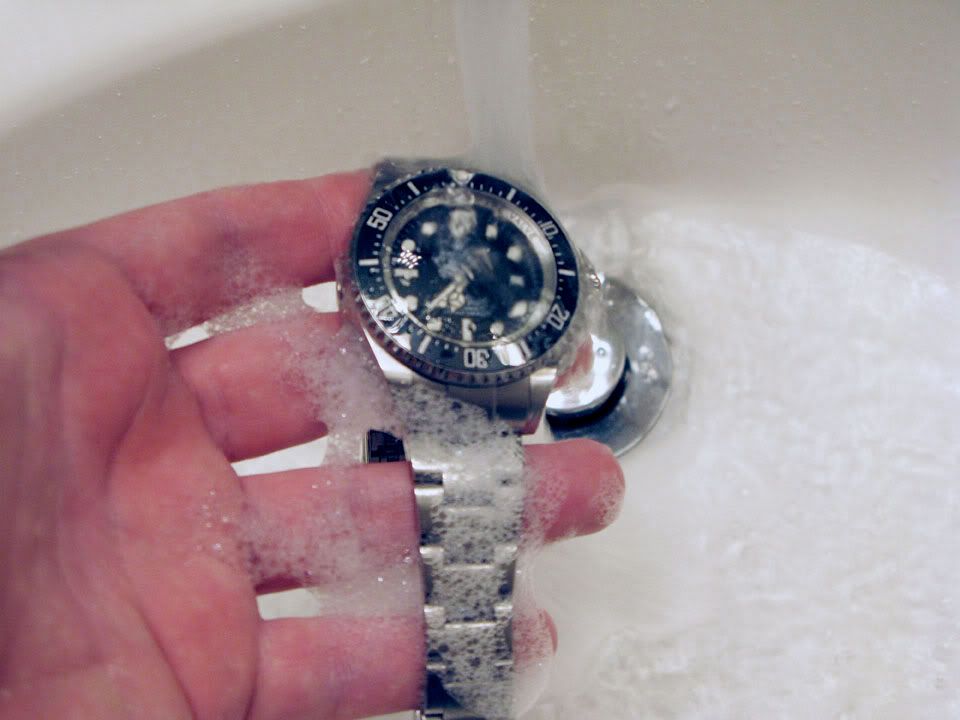
After you've dried it completely, take your refinishing pad & buff in gentle downward strokes, moving away from the case. Make sure to keep your motion uniform & straight unless you want swirl marks; only move in one direction--not up and down--and do not buff in circles.
If you wish, you can unscrew a link in the band and lay it flat:

Or, if you feel more confident & steady, you can simply hand-hold it:

Of course, some scratches will take a bit longer to buff out than others. Depending on which model & which case, there are places on the case that require a satin/brushed finish, and not a polished one. For instance, on the top of the DeepSea's lugs, the surface area is brushed, as opposed to being polished on the sides; I like to keep that touched up as well:

NOTE: Be wary as to not let any part of the pad touch the polished sides of the case, so as not to scratch it--I like to keep it snug around the tip of my finger.
As every watch is different, make a note as to which way the "grain", if you will, is supposed to go on your case and try to replicate that same pattern when buffing:

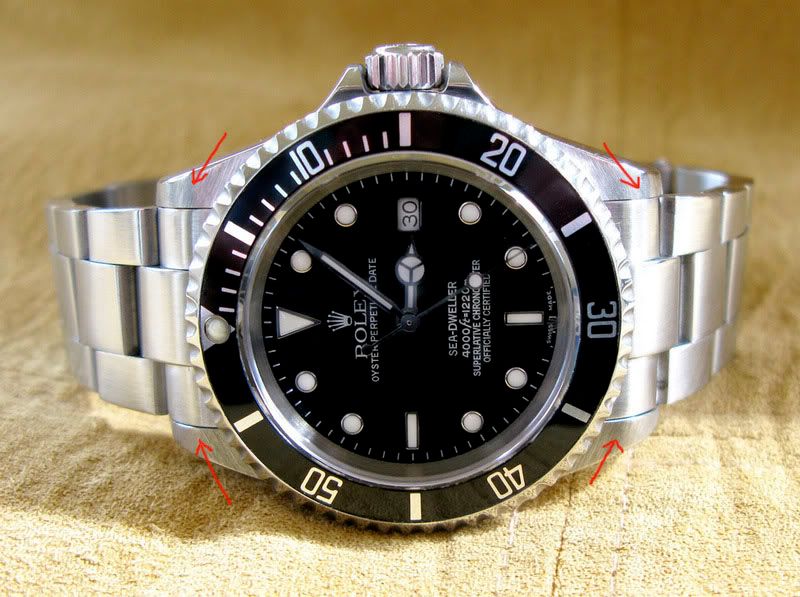
After you've gotten out your scratches, and the finish on the steel is all uniform--in one direction (best to check in as bright a light as possible before proceeding)--then grab your polishing cloth and buff it a bit (to your liking) to tone down the grain left behind by the refinishing pad and to give it more of a gen-like, 904L shine. With this particular cloth, I recommend buffing in both directions:
With this particular cloth, I recommend buffing in both directions:

NOTE: With this cloth as well, make sure not to buff any of the highly polished areas (like the case sides) or you'll loose that high sheen and wind up with swirl marks in bright light.
Here are some before & after shots to show you just how effective these products truly are (notice the scratches on the SELs):
Before:

After:

Before (notice the scratches on the clasps):
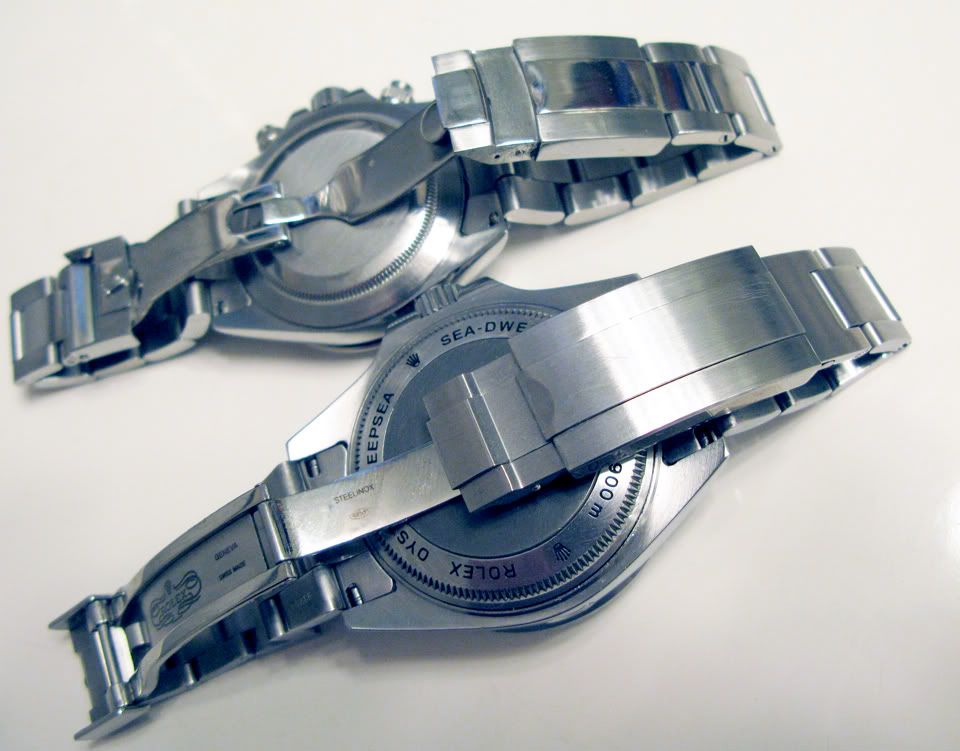
After:

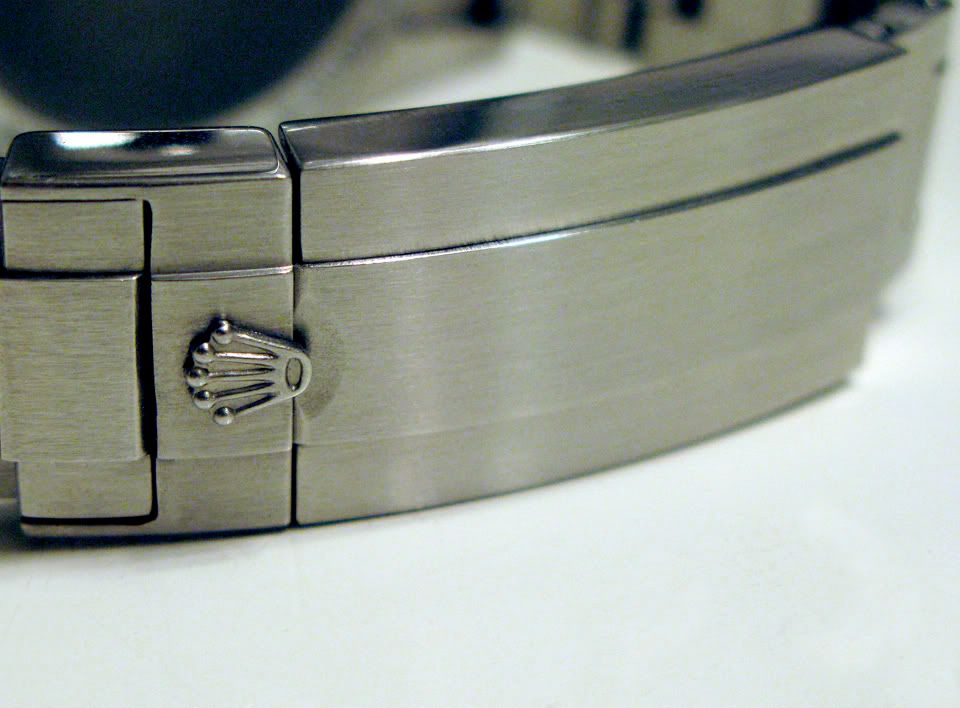
That's pretty much it; repeat as necessary.
THE EXPANDED VERSION (for bands & cases with a combination of polished and brushed surfaces):
For this version, you'll start off with the exact same materials as above, with the addition of a screw-driver; and for the Americans, a roll of Scotch-tape, and for the Scottish, a role of sellotape:
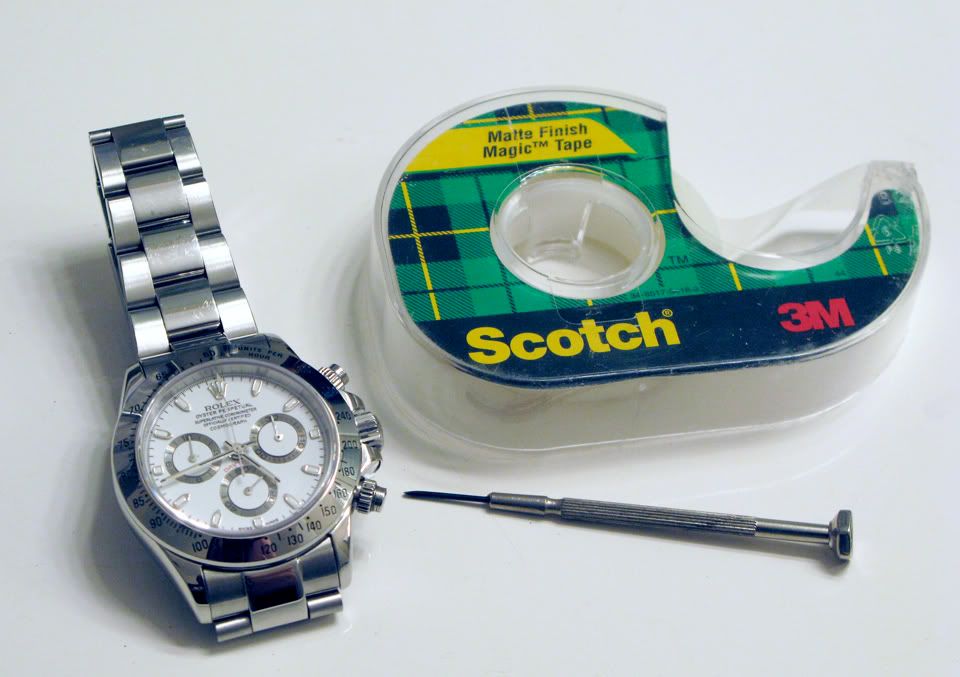
I've said it before, and I HIGHLY recommend anyone at home wishing to keep their pieces looking perfect needs to invest in a bench grinder:

They're quite inexpensive, as well; here's one for $29 dollars:
http://www.amazon.com/Grizzly-G9717-Ben ... 487&sr=8-2
And here's the one I have for $39:
http://www.kaboodle.com/reviews/the-hom ... with-light
These are more effective than a Dremel for better polishing results and no swirl marks. Since these are technically "grinders" and not "buffers", all you have to do is remove one of the grinding wheels and attach a polishing wheel with a few washers to snug it up.
http://www.amazon.com/Buffing-Polishing ... 726&sr=8-7
Cheaper than a $300-500 jewelers buffer and just as effective. Make sure to pick up a stick of white rouge, too:
http://www.amazon.com/oz-White-Rouge-Po ... 825&sr=8-1
NOTE: The key to a beautiful, high-polished shine with no swirl-marks is: the dirtier the buffing wheel, the better the shine. I've had the same wheel for years, clotted with rouge and spent metal particles. Remember, clean wheels leave swirl marks!
Ok--start by washing your piece with a bit of soap and warm water. Dry it, then tape off one side of the band, to cover the polished center-links:

As above, with gentle strokes move in a straight line, away from the case and down the band:

When finished, check your results, then repeat the process with the other side of the links:

Then, while the center links are still taped off, use your polishing cloth to add a shine to the top of the satin/brushed bits (move back and forth, not just in one direction):


Once this is finished, tape off the brushed links so that only the polished center links are exposed:

Apply a fair amount of your white rouge to the buffing wheel (when spinning):

And begin to buff out the scratches on your center links.

NOTE: Be wary of which way the disc is spinning; if it catches the right part, you'll find it's ripped the watch out of your hands before you know it. Also make sure not to apply too much pressure as the heat from the friction created will melt the tape, and you'll wind up having to re-brush the outer links all over again.
Once this is finished, you'll find a black residue, built up from the spent rouge & metal dust. Grab a toothbrush with some dish-soap, and scrub it off:

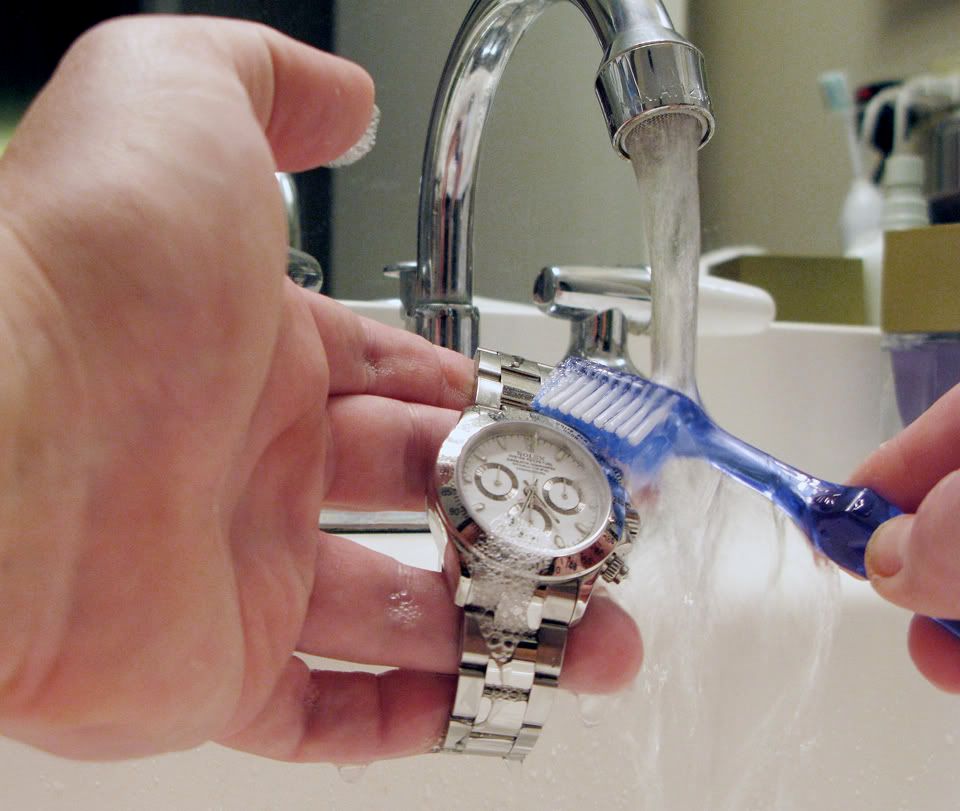
You can apply this same technique to polishing the case as well.
Here are some before and after shots, to show you the effectiveness:
Before:


After:


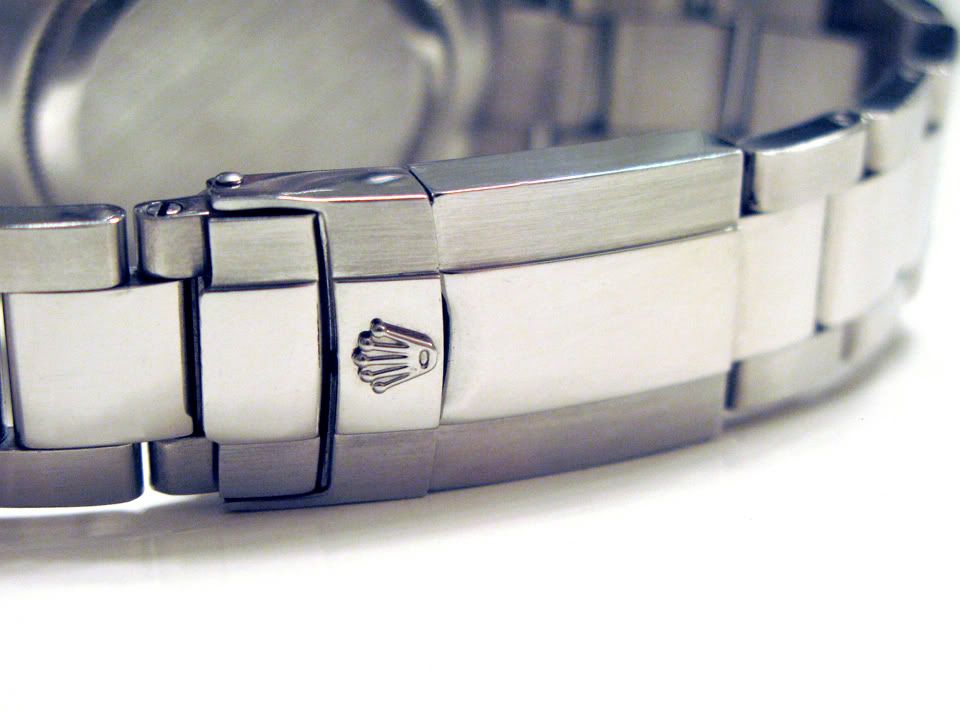
You'll be amazed how quick & easy it is to keep your timepieces looking pristine, and always have a gen-like shine.
That's it; hope you enjoy!

A lot of people--including on the boards--seem to remark that my watches always look "unworn", so I thought I'd do a quick "how to" on how I keep the finish on my pieces.
This tutorial will only cover superficial scratches and not deep ones--for that, I know another member made a wonderful, in-depth tutorial on sanding & polishing out deep case scratches, but I can't find it to save my life, so if anyone else can locate it, feel free to post it here. And please forgive the strange lighting for this shoot, as I tried to play with it to be able to better show the detail of finish in the steel, which can be hard to accurately shoot & get it to appear on film as it looks to the naked eye--especially with minor scratches.
For the most part, I try to be conscientious (desk diving, etc.) about how I treat my watches, both on and off the wrist; this tends to do wonders for the amount of scratches that will eventually have to be removed. And when that time inevitably comes, here's how I keep them looking "unworn".
THE SHORT & SIMPLE VERSION
Here's what you'll need:
A refinishing pad--either in pad or block form--I prefer the refinishing pad.

Here's where you can find them:
http://www.bostonwatchexchange.com/serv ... hes/Detail
http://www.esslinger.com/rubberizedfini ... oarse.aspx
And a polishing cloth (NOT Cape Cod)

Here's the specific one I use:
http://www.amazon.com/Pierce-This-2-Pol ... 87&sr=8-21
I must say, I am against using Cape Cod cloths for this sort of job. I recommend the one pictured above because it has a completely different application fabric, and a much, much lighter chemical base. The material is too coarse on Cape Cods, has a tendency to leave swirl marks on the finish, and the chemical it's treated with is strong enough to remove tarnish from copper; quite frankly, I don't want it on my watches. A lot of people also use Cape Cod cloths, as they supposedly "polish" away scratches. In your average room's low-light, it might appear that they've been reduced, but step outside in natural light and you will see your highly-polished surfaces riddled with swirl-marks. You'll also notice that a lot of people not experienced in polishing jewelry will tout the "benefits" of CC cloths, but the fact of the matter is, without a high-speed buffing wheel and proper jewelers rouge, it is IMPOSSIBLE to completely remove scratches from highly polished metal; CC cloths simply do not cut it. You'll also notice when people who use these photograph their finished watches, they do not shoot them in a parallel angle to their light source, and certainly don't shoot them in natural light, as these have a tendency to expose all the flaws left behind by Cape Cod.
My advice is, if you want to see the same fabulous results as you've seen in my Rolex reviews, avoid CC cloths. Leave Cape Cod to the Kennedys.
First off, start by washing your piece with a bit of dish-soap & warm water (if you're afraid your piece isn't waterproof, you can skip the first step, or check my signature for a waterproofing how-to).

After you've dried it completely, take your refinishing pad & buff in gentle downward strokes, moving away from the case. Make sure to keep your motion uniform & straight unless you want swirl marks; only move in one direction--not up and down--and do not buff in circles.
If you wish, you can unscrew a link in the band and lay it flat:

Or, if you feel more confident & steady, you can simply hand-hold it:

Of course, some scratches will take a bit longer to buff out than others. Depending on which model & which case, there are places on the case that require a satin/brushed finish, and not a polished one. For instance, on the top of the DeepSea's lugs, the surface area is brushed, as opposed to being polished on the sides; I like to keep that touched up as well:

NOTE: Be wary as to not let any part of the pad touch the polished sides of the case, so as not to scratch it--I like to keep it snug around the tip of my finger.
As every watch is different, make a note as to which way the "grain", if you will, is supposed to go on your case and try to replicate that same pattern when buffing:


After you've gotten out your scratches, and the finish on the steel is all uniform--in one direction (best to check in as bright a light as possible before proceeding)--then grab your polishing cloth and buff it a bit (to your liking) to tone down the grain left behind by the refinishing pad and to give it more of a gen-like, 904L shine.

NOTE: With this cloth as well, make sure not to buff any of the highly polished areas (like the case sides) or you'll loose that high sheen and wind up with swirl marks in bright light.
Here are some before & after shots to show you just how effective these products truly are (notice the scratches on the SELs):
Before:

After:

Before (notice the scratches on the clasps):

After:


That's pretty much it; repeat as necessary.
THE EXPANDED VERSION (for bands & cases with a combination of polished and brushed surfaces):
For this version, you'll start off with the exact same materials as above, with the addition of a screw-driver; and for the Americans, a roll of Scotch-tape, and for the Scottish, a role of sellotape:

I've said it before, and I HIGHLY recommend anyone at home wishing to keep their pieces looking perfect needs to invest in a bench grinder:

They're quite inexpensive, as well; here's one for $29 dollars:
http://www.amazon.com/Grizzly-G9717-Ben ... 487&sr=8-2
And here's the one I have for $39:
http://www.kaboodle.com/reviews/the-hom ... with-light
These are more effective than a Dremel for better polishing results and no swirl marks. Since these are technically "grinders" and not "buffers", all you have to do is remove one of the grinding wheels and attach a polishing wheel with a few washers to snug it up.
http://www.amazon.com/Buffing-Polishing ... 726&sr=8-7
Cheaper than a $300-500 jewelers buffer and just as effective. Make sure to pick up a stick of white rouge, too:
http://www.amazon.com/oz-White-Rouge-Po ... 825&sr=8-1
NOTE: The key to a beautiful, high-polished shine with no swirl-marks is: the dirtier the buffing wheel, the better the shine. I've had the same wheel for years, clotted with rouge and spent metal particles. Remember, clean wheels leave swirl marks!
Ok--start by washing your piece with a bit of soap and warm water. Dry it, then tape off one side of the band, to cover the polished center-links:

As above, with gentle strokes move in a straight line, away from the case and down the band:

When finished, check your results, then repeat the process with the other side of the links:

Then, while the center links are still taped off, use your polishing cloth to add a shine to the top of the satin/brushed bits (move back and forth, not just in one direction):


Once this is finished, tape off the brushed links so that only the polished center links are exposed:

Apply a fair amount of your white rouge to the buffing wheel (when spinning):

And begin to buff out the scratches on your center links.

NOTE: Be wary of which way the disc is spinning; if it catches the right part, you'll find it's ripped the watch out of your hands before you know it. Also make sure not to apply too much pressure as the heat from the friction created will melt the tape, and you'll wind up having to re-brush the outer links all over again.
Once this is finished, you'll find a black residue, built up from the spent rouge & metal dust. Grab a toothbrush with some dish-soap, and scrub it off:


You can apply this same technique to polishing the case as well.
Here are some before and after shots, to show you the effectiveness:
Before:


After:



You'll be amazed how quick & easy it is to keep your timepieces looking pristine, and always have a gen-like shine.
That's it; hope you enjoy!
